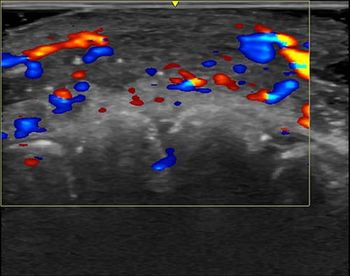
German researchers confirm superiority of PET/CT imaging
PET/CT is significantly more accurate than CT alone, PET alone, and side-by-side CT and PET when assessing the TNM stage of different malignant diseases. This diagnostic advantage translates into treatment plan changes in a substantial number of patients, according to a report at the 2004 RSNA meeting by Dr. Gerald Antoch and colleagues at University Hospital Essen in Germany.
PET/CT is significantly more accurate than CT alone, PET alone, and side-by-side CT and PET when assessing the TNM stage of different malignant diseases. This diagnostic advantage translates into treatment plan changes in a substantial number of patients, according to a report at the 2004 RSNA meeting by Dr. Gerald Antoch and colleagues at University Hospital Essen in Germany.
Researchers viewed scans from 260 consecutive patients (167 female) with different oncological diseases who had undergone FDG-PET/CT for tumor staging: 112 patients were imaged for primary tumor staging and 148 for suspected recurrent disease. The majority of patients had malignant non-small cell lung carcinoma, followed by head and neck tumors, gastrointestinal tumors, and others.
PET/CT imaging was performed on a Siemens Biograph scanner with an axial field-of-view from head to upper thigh. Investigators used IV contrast CT for diagnostic data.
Two nuclear medicine specialists viewed the PET alone images. They evaluated the images first qualitatively by the areas of increase glucose metabolism, then quantitatively by the standard uptake value (SUV).
An SUV cutoff value for malignancy of 2.5 was used for all organs except the liver, which had a value of 3.5. The difference in cutoff values was based on an analysis of the literature, which showed that FDG uptake is generally higher in the liver than the rest of the body organs.
Two radiologists evaluated the CT images, which determined whether lymph nodes were metastatic based on size. Side-by-side images were evaluated by radiologists and nuclear medicine specialists on two different screen: CT on the right, PET on the left. The images were purposely misregistered to ensure a degree of objectivity.
The same radiologists and nuclear medicine specialists reviewed the fused images one month after evaluating the side-by-side image analysis. Increased glucose metabolism was again used to determine pathology.
Researchers performed an analysis separately for the T-, N-, and M-stage. In addition, they determined the impact of PET/CT on patient management.
Histopathology was the standard of reference for 77 patients for the T-stage, 72 patients for N-stage, and 57 patients for M-stage. For all other patients, a mean clinical follow-up of 311 served as the standard of reference.
Fused PET/CT proved significantly more accurate in assessing the overall TNM stage compared with CT alone, PET alone, and side-by-side CT plus PET. Of all 260 patients, 84% were correctly staged with PET/CT, 76% with side-by-side CT plus PET, 64% with PET alone, and 63% with CT alone.
Sensitivities and specificities for characterization of the N-stage were, respectively, 92% and 93% for PET/CT, 88% and 89% for CT plus PET, 85% and 88% for PET, and 64% and 83% for CT. Sensitivities and specificities for assessment of the M-stage were, respectively, 94% and 97% with PET/CT, 92% and 96% with CT plus PET, 78% and 99% with PET, and 82% and 95% with CT.
"The most important point is whether PET/CT impacted patient management," Antoch said. "Does it change patient therapy from palliative to curative, from curative to palliative? Or does it change the surgical approach from extended to limited surgery?"
Combined PET/CT had an impact on the treatment plan in 17% of patients compared with PET alone, in 15% of patients compared with CT alone, and in 6% of patients compared with side-by-side CT plus PET.
Newsletter
Stay at the forefront of radiology with the Diagnostic Imaging newsletter, delivering the latest news, clinical insights, and imaging advancements for today’s radiologists.




























